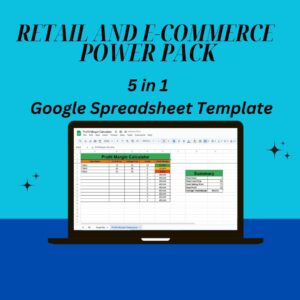what are the five marketing strategies that retailers spend on half of there annual budget on

Introduction
Marketing is the backbone of retail success. Every year, retailers allocate a significant portion of their budget to various marketing strategies to drive traffic, increase sales, and build brand loyalty. In fact, studies show that retailers spend nearly 50% of their annual budget on just five core marketing strategies.
In this blog, we’ll explore:
✔ The top five marketing strategies retailers invest in
✔ Why these strategies are effective
✔ How businesses can maximize their marketing spend
Digital Advertising (PPC & Social Media Ads)
-
Sale!

Expense Tracker Advanced
Rated 0 out of 5$8.99Original price was: $8.99.$4.99Current price is: $4.99. -
360° Mastery SuperPack
Rated 0 out of 5$19.99 -
Marketing PowerPack
Rated 0 out of 5$9.99 -
Retail and E-Commerce PowerPack
Rated 0 out of 5$9.99
One of the biggest marketing expenses for retailers is paid digital advertising, including:
✔ Pay-per-click (PPC) advertising (Google Ads, Bing Ads)
✔ Social media advertising (Facebook, Instagram, TikTok, LinkedIn)
✔ Display ads and remarketing campaigns
Why Retailers Invest in Digital Ads
📌 Instant visibility – PPC ads appear at the top of search results.
📌 Highly targeted – Ads reach specific demographics based on location, interests, and behavior.
📌 Measurable ROI – Every ad click and conversion can be tracked.
💡 Example:
A fashion retailer spends $50,000 per month on Facebook and Instagram ads to promote seasonal collections, driving traffic to their website and increasing sales.
How to Maximize Digital Ad Spend
✔ Use retargeting – Show ads to visitors who didn’t complete a purchase.
✔ A/B test different ad creatives – Improve engagement by testing images, copy, and CTA buttons.
✔ Focus on high-intent keywords – Target people who are actively looking for products.
Influencer Marketing & Brand Collaborations
Retailers are investing heavily in influencer partnerships to boost brand awareness and sales.
Why Retailers Use Influencer Marketing
📌 Trust & credibility – Consumers trust recommendations from influencers.
📌 Access to niche audiences – Influencers help brands connect with targeted groups.
📌 Higher engagement rates – Influencer-generated content gets more interactions than traditional ads.
💡 Example:
A beauty retailer collaborates with a TikTok beauty influencer to showcase a new skincare line, leading to a 30% increase in sales within a month.
How to Maximize Influencer Marketing
✔ Partner with micro-influencers – They have higher engagement rates than celebrities.
✔ Use affiliate marketing – Give influencers custom discount codes to track sales.
✔ Encourage user-generated content – Get customers to share their purchases on social media.
SEO & Content Marketing
Retailers allocate a significant portion of their budget to search engine optimization (SEO) and content creation to drive organic traffic.
Why SEO & Content Marketing Matter
📌 Long-term results – Unlike paid ads, SEO delivers traffic without ongoing ad spend.
📌 Higher conversion rates – Customers trust organic search results more than ads.
📌 Improved brand authority – Content marketing establishes expertise and credibility.
💡 Example:
An electronics retailer invests in blog posts, product guides, and video tutorials optimized for SEO. After six months, their organic traffic grows by 45%, reducing dependence on paid ads.
How to Maximize SEO & Content Marketing
✔ Optimize for long-tail keywords – Target specific product searches.
✔ Create video content – Videos rank well on Google and YouTube.
✔ Focus on local SEO – Optimize Google My Business for in-store traffic.
Email & SMS Marketing
Retailers use email and SMS marketing to nurture customer relationships and boost repeat sales.
Why Email & SMS Marketing Are Essential
📌 High ROI – Email marketing generates an average of $42 for every $1 spent.
📌 Direct customer engagement – SMS messages have an open rate of over 90%.
📌 Personalization opportunities – Brands can send tailored offers based on customer behavior.
💡 Example:
An online clothing store sends personalized product recommendations based on a customer’s browsing history, leading to a 20% increase in repeat purchases.
How to Maximize Email & SMS Marketing
✔ Segment your audience – Send targeted messages based on purchase history.
✔ Use automation – Set up cart abandonment emails and SMS reminders.
✔ Offer exclusive discounts – Encourage loyalty with VIP-only promotions.
Loyalty Programs & Customer Retention Strategies
Retailers allocate a large portion of their budget to customer retention because acquiring a new customer costs 5x more than retaining an existing one.
Why Retailers Invest in Loyalty Programs
📌 Encourages repeat purchases – Customers return to earn rewards.
📌 Increases customer lifetime value – The longer a customer stays, the more they spend.
📌 Drives referrals – Loyal customers bring in new buyers.
💡 Example:
A coffee shop chain offers a “Buy 10, Get 1 Free” loyalty program. Customers visit more often to earn rewards, increasing sales by 25%.
How to Maximize Loyalty Programs
✔ Make it easy to join – Offer instant sign-ups with a phone number or email.
✔ Use a points-based system – Let customers earn points for purchases and referrals.
✔ Offer exclusive VIP perks – Provide early access to sales or free shipping.
Final Thoughts: Where Should Retailers Invest?
📌 Key Takeaways:
✔ Digital advertising captures immediate traffic and sales.
✔ Influencer marketing builds trust and expands audience reach.
✔ SEO & content marketing drive organic growth and brand authority.
✔ Email & SMS marketing nurture customers and increase repeat sales.
✔ Loyalty programs enhance retention and customer lifetime value.
🚀 Want to maximize your marketing budget? Focus on a mix of these five strategies to drive long-term success!

Get Your FREE Expense Tracker Template Now!
Simplify your finances and gain full control over your budget – Download instantly!
✅ Over 10,000 downloads and counting!
💼 Perfect for personal and business use.
🔐 We respect your privacy.



